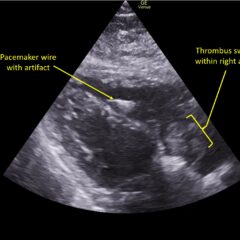Drowning Complicated by Hypothermia
ABSTRACT:
Audience:
This scenario was developed to educate emergency medicine residents on the diagnosis and management of two concurrent conditions: drowning and hypothermia.
Introduction:
Patients who present after drowning may have delayed respiratory compromise without immediate radiographic pathological findings, highlighting the need for continued observation. The presentation and management of patients with hypothermia depends on multiple factors, including core temperature. Emergency physicians should be aware of hypothermia’s underlying pathophysiology, associated dysrhythmias, and different warming methods.
Educational Objectives:
At the conclusion of the simulation session, learners will be able to: 1) obtain a relevant focused history, including circumstances of drowning and/or cold exposure; 2) outline different clinical presentations of hypothermia, loosely correlated with core temperature readings; 3) discuss management of hypothermia, including passive external rewarming, active external rewarming, active internal rewarming, and extracorporeal blood rewarming; 4) discuss pathophysiology of drowning; 5) identify appropriate disposition of patients who present after drowning; and 6) identify appropriate disposition of hypothermic patients.
Educational Methods:
This session was conducted using high-fidelity simulation, followed by a debriefing session and discussion about the diagnosis, differential, and management of both drowning and hypothermia. Debriefing methods may be left to the discretion of participants, but the authors have utilized advocacy-inquiry techniques. In this technique, the facilitators describe something they observed in the case, outline their reasoning as a facilitator why this observation was important or why they had questions, and then ask the learners to share their frame of reference at the time. An example: “I heard someone say that both chest tubes should be placed on the left, but then another resident said ‘I disagree.’ No one paused to come to a consensus. I’m wondering why this wasn’t explored further in real time. Tell me more.” This scenario may also be run as a structured interview case.
Research Methods:
Our residents were provided a survey at the completion of the debriefing session so they might rate different aspects of the simulation, as well as provide qualitative feedback on the scenario. The local institution’s simulation center’s electronic feedback form is based on the Center of Medical Simulation’s Debriefing Assessment for Simulation in Healthcare (DASH) Student Version Short Form1 with the inclusion of required qualitative feedback if an element was scored less than a 6 or 7.
Results:
Seventeen learners filled out a feedback form. This session received a majority of 6 and 7 scores (consistently effective/very good, and extremely effective/outstanding, respectively) other than four 5 scores.
Discussion:
This is a cost-effective method for reviewing hypothermia and drowning. The case may be modified for appropriate audiences, such as simplifying the case to either drowning or hypothermia. The setting of the emergency department may also be changed to reflect different available resources (academic center or freestanding emergency department), such as the absence or presence of ZOLL catheters or ability to activate an extracorporeal membrane oxygenation (ECMO) team.
Topics:
Medical simulation, drowning, hypothermia, environmental emergencies, emergency medicine.

